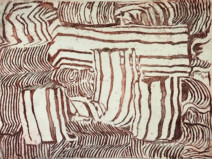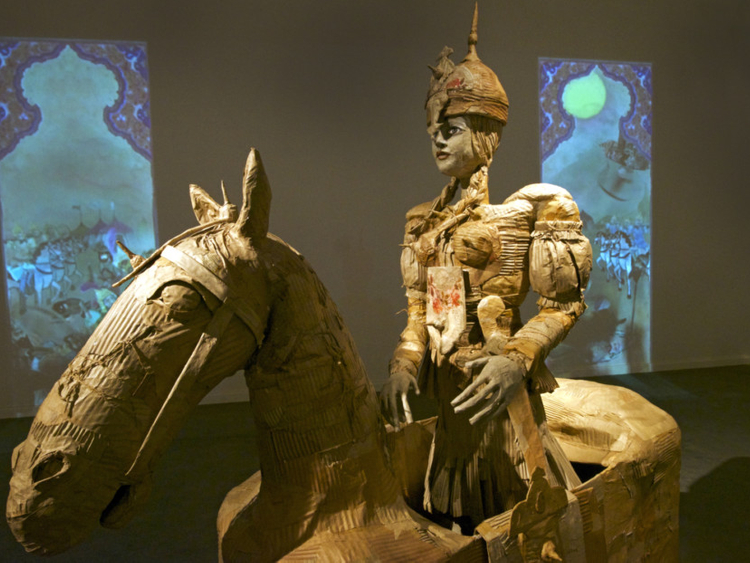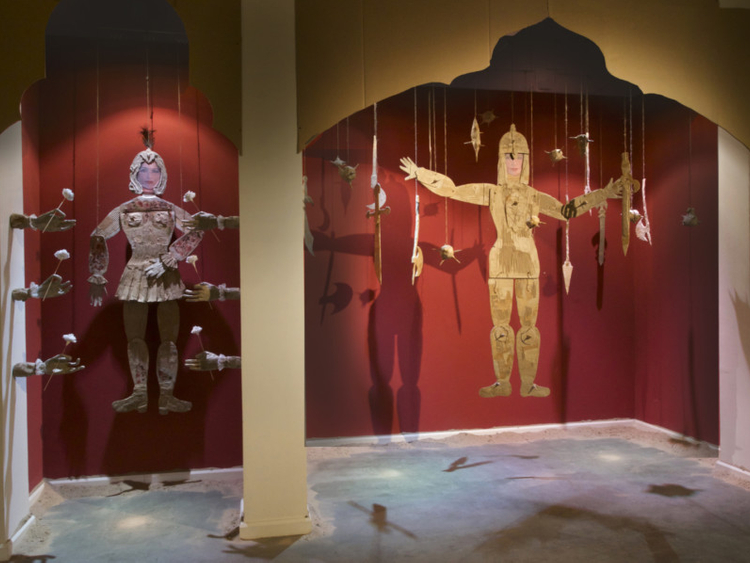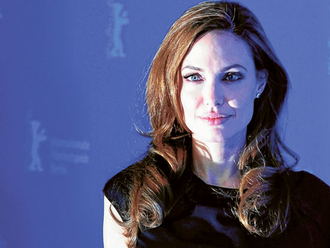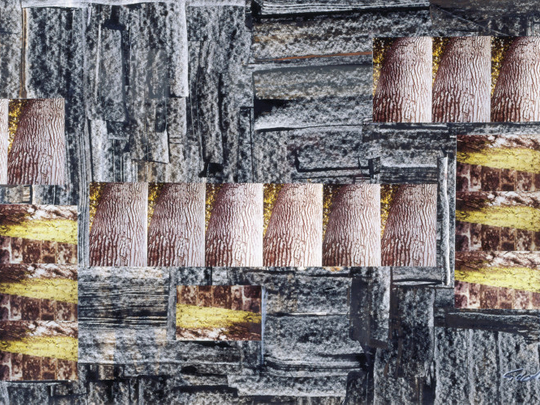
Total Arts at the Courtyard has launched a new series of exhibitions that aims to set up dialogues between the works of artists from different generations. The first show in this series, titled “Visual Dialogues” looks at the work of Behjat Sadr and Nazgol Ansarinia — two well-known Iranian women artists from different centuries.
Sadr (1924 -2009) was a pioneer of modern Iranian art, known for her abstract paintings and collages and innovative experiments with three-dimensional and kinetic art.
Ansarinia, who was born in 1979, is a pioneer of contemporary Iranian art, and is carrying forward Sadr’s legacy into the 21st century with her minimalist three-dimensional works and attention to detail and craftsmanship.
The exhibition, curated by Fereydoun Ave and Shaqayeq Arabi, features a mini retrospective of Sadr’s work, with some being shown in public for the first time.
Acclaimed Iranian filmmaker and artist Mitra Farahani’s documentary “Behjat Sadr: Time Suspended” is also being screened at the exhibition to give visitors a deeper insight into Sadr’s work.
Juxtaposed with Sadr’s artworks are Ansarinia’s pieces from various well-known series, including “Patterns”, for which she won the Abraaj Capital Art Prize in 2009. The show highlights the similarities in the inspirations, thought processes and research of the two artists, and the innovative ways they have used the tools and materials available to them to address the aesthetics and socio-economic issues of their times.
Sadr used everyday objects such as Venetian blinds to create innovative kinetic 3D works. The piece in this show, from 1969, is an abstract painting almost concealed by blinds that have been painted black on one side and silver on the other. The reflection of the painting gradually becomes visible on the silvered side of the blinds as viewers move across the work.
Ansirinia has also taken inspiration from her surroundings in the 3D works in her “Fabrications” series from 2013. Using plaster, resin and paint she has created models of buildings in Tehran, but with a twist.
In her sculptures, the facades of the buildings are flat, whereas the murals of rural landscapes and mosques, typically painted on their sides, are three dimensional, thus highlighting the constant struggle between tradition and modernity in Iranian society.
In her “Reflections/ Refractions” series from 2011-12, Ansarinia has used a geometric grid similar to that used in Iranian mirror mosaics to weave together and dissect reports in a newspaper, drawing parallels between the distortion of the images reflected in these mosaics and the distortion of reality by the media. The works resonate with Sadr’s geometric patterns created with tape on wood or metal, which are also inspired by traditional Islamic patterns.
Sadr took inspiration from everyday sights, such as the abstract patterns created on the windshield of her car during a car wash, to talk about the beauty that we can find in everything around us. Ansarinia was also inspired by the cheap plastic tablecloths sold by street vendors in Tehran in her “Non flammable, Non-stick, Non-stain” series.
By morphing statistical reports of daily expenses into delicate patterns on her tablecloths, she comments on contemporary socio-economic issues. Similarly, in her “Patterns” series, the patterns that look like traditional designs on Iranian carpets are actually composed of images from contemporary life. Also on display is another series by Ansarinia, which is based on words from the calligraphic slogans seen in public spaces in Tehran in a bid to examine the influence of the ubiquitous, but barely noticed messages.
“The Inbetween Space at Total Arts at the Courtyard, which will host this series, is envisioned as a space that can fill the gap between commercial galleries and cultural institutions, by hosting exhibitions that are educational and research oriented. In the next exhibition, planned to coincide with Abu Dhabi Art, we will set up a dialogue between modern Iranian master Charles Hossein Zenderoudi and renowned American artist Cy Twombly,” says Ave.
Jyoti Kalsi is an arts enthusiast based in Dubai.
“Visual Dialogues” will run in The Inbetween Space at Total Arts at the Courtyard, Al Quoz until April 20
Ode to Women
Dubai-based artist Yasmin Sinai creates beautiful sculptures from recycled paper and cardboard. Her latest show “Act of Gordafarid, the female warrior” features works inspired by Gordafarid, the only female warrior mentioned in Persian poet Firdausi’s epic work, the Shahnameh.
“Gordafarid fought bravely against the mighty hero Sohrab to protect her father’s castle, earning his respect, and becoming a symbol of courage and wisdom for Iranian women. I want to present this ancient legend in a contemporary context by depicting Gordafarid as a modern-day warrior — a woman who plays many roles in society, and fights for her right to pursue her dreams and desires. This show is about the theatre of life, and the many facets of the 21st century woman warrior,” Sinai says.
She tells the story through a series of theatrical installations depicting dramatic scenes featuring warriors, horses and weapons crafted from paper and cardboard. Animated videos, created by Sinai’s son, Massih Parsaei add a contemporary touch to the works.
In one scene, Gordafarid stands in a battlefield in the desert, surrounded by fearsome masks, and her head replaced by a horse’s head. “The horse is a symbol of life. And in life we have victories and defeats. Sometimes we ride the horse, and at other times the horse rides us. Here Gordafarid is surrounded by her fears and the pressures of life, and must find the courage to fight them,” says Sinai.
Other scenes are inspired by the Paper Theatre and the ancient Persian Pardeh Khani style of story-telling, using paper puppets and figures and scenes projected on a curtain. In one scene the artist presents the soft, romantic side of a woman, showing her in her boudoir, wearing a pretty dress, with several admirers offering her roses. But her tough side is also evident in the helmet she wears and the spikes on her dress.
The story ends with Gordafarid riding her horse as a victorious warrior. Animated battle scenes from the Shahnameh, projected on the wall behind her complete the picture.
The show will run at Total Arts at the Courtyard until April 20.



